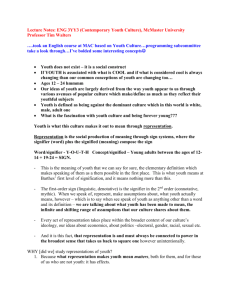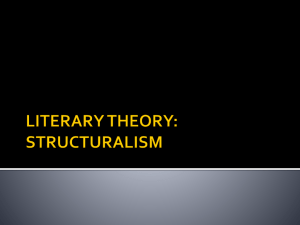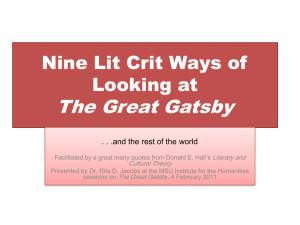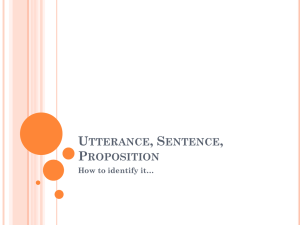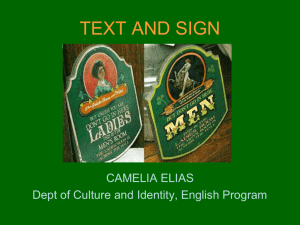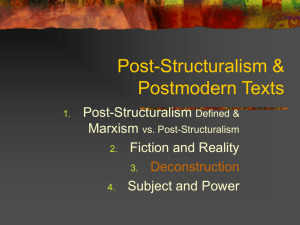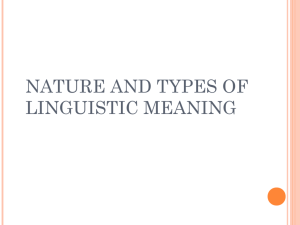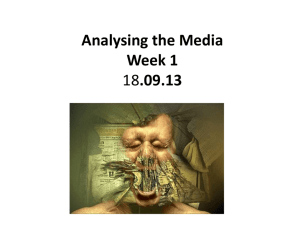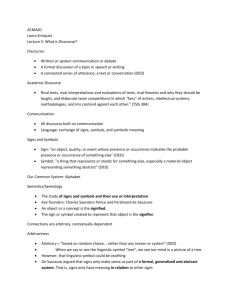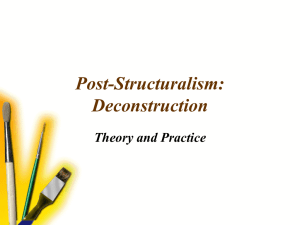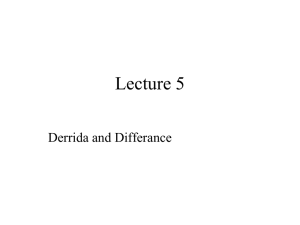Everyday Use
advertisement
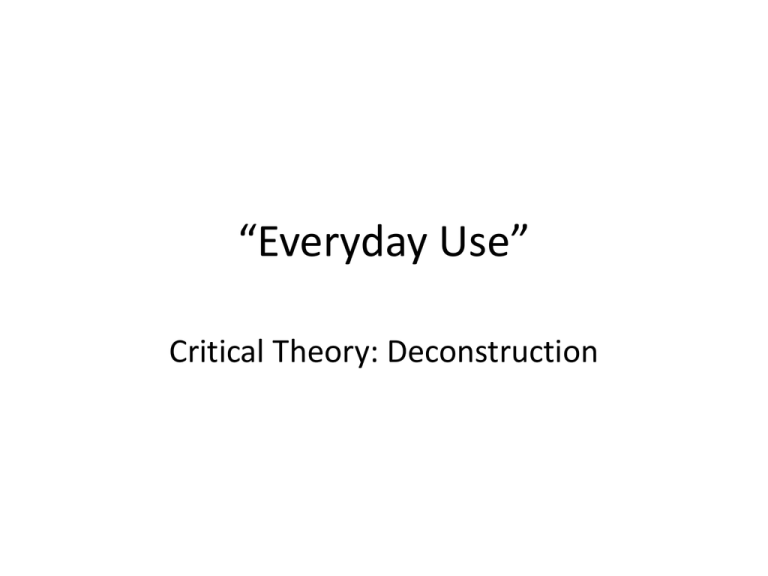
“Everyday Use” Critical Theory: Deconstruction A brief introduction… • In order to understand Deconstruction, we must understand the major points of Structuralism, which claims… – Every word/idea only gets its significance from its relationship to other words/ideas. – This complex web of relationship creates a stable, structure that can be described and understood. Key Ideas from Structuralism that Will be Important Later Ferdinand de Saussure’s concepts of sign, signifier, and signified are at the core of Structuralism and Deconstruction. These are words Saussure used to explain how language makes meaning out of abstract concepts. • The signified is the concept or idea that a word refers to. • The signifier is the word itself. • The sign is the combination of the two – the word applied to the concept. • The study of signs, and how this whole process works, is called semiotics. Examples of Signified, Signifier, and Sign: • Example 1: “Desk” – Signified: The concept of a place where people (possibly students, possibly office workers or others doing tasks that involve paper or study) sit. – Signifier: The word “desk.” (The actual sound you make when you say it, or the written word.) – Sign: The word “desk” when it is used to refer to the concept of a place where students/workers sit. Examples of Signified, Signifier, and Sign: • Signs are not always word-idea combinations! Objects can function as signs, too. • Example 2: A Box of Chocolates on Valentine’s Day (Thank you, Donald Hall, for this example). – Signified: The concept of affection, specifically, romantic love. – Signifier: The object: in this case, a physical box of chocolates. – Sign: The box of chocolates as an expression of affection. What do These Two Examples Tell Us? • Signifiers (the words or objects themselves) are dependent on the concepts they signify for meaning. Without the concept of love/affection, the box of chocolates is just food. Without the concept of a place where students/workers sit, the word “desk” is just a nonsense word. Signs in Relationship to Each Other • Structuralists believed that “signs are intelligible through the way they relate to each other” (Hall 136). In other words, signs can be understood by examining them in relationship to other related signs. • The binary was one relationship that Structuralists explored. A binary is a relationship of opposites that often depend on each other for meaning. – – – – Love/Hate Hot/Cold Heaven/Hell Notice how one half of each of these binaries is “better”? That is the privileged half of the binary. So… Why did this make Structuralists so excited? • Because signs are everywhere in our daily lives – our language is built on them, but so is our artistic and cultural expression. • Because they thought that if they could just understand how signs work completely, they would be able to understand everything about human existence. This may seem arrogant, but Saussure really thought that he, and those who came after him, were feeling their way towards a “Theory of Everything.” Deconstruction Rains on Our Parade a Little… • Deconstruction is a rejection of some of the central claims of structuralism. • Deconstruction claims that the relationship between sign, signifier, and signified is not stable. • Going back to our examples of the desk and the box of chocolates… • One signifier can have a whole range of meanings (it can have more than one signified with which to make more than one sign). Is a desk always a place where a student/worker sits? What about a CEO’s desk? What about the President’s desk? Does a box of chocolates always signify romantic love? (To “signify” is “to be a signifier of” a concept/idea.) • Deconstructionist critics believe that we could keep going like this forever and never arrive at any stable, certain meaning for either of these signs. Assumptions that Deconstruction Makes: • There is no “universal truth” (Derrida called it a “transcendental signified”) that is waiting to be discovered within a text, or within a “sign system.” All a literary critic can do is critique, analyze, and invite others to critique what he or she has said. • Relationships between signs exist, and they can even produce meaning, but neither relationships nor meaning are ever certain or stable. • Texts (including works of literature) contain evidence of this instability and uncertainty if you look close enough. (Deconstructionist critics tend to be very close readers.) What is Deconstruction as a Literary Theory? • In terms of literary theory, Deconstruction rejects the Structuralist idea that any literary work has a stable, closed meaning, or a “center” around which the rest of the work revolves. • Deconstructive critics look at the way that plural, multiple meanings occur in works of literature, and how those multiple meanings interact with one another. • Deconstructive critics also look for ways in which either/or readings (usually about pairs of opposites called binaries) in a given text break down or become unstable. What questions might Deconstructive Critics ask? • What ideas or characters seem to be in opposition in this work, and how does the work avoid privileging (seeming to give preference to) one of them? In other words, how does the work create ambiguity? • What interpretive possibilities are presented by this ambiguity? • How do various possible meanings presented by the text play off of each other? Questions to Begin Our Discussion • What ideas/characters seem to be opposed to each other in this story? Where is there conflict between opposites? • What similarities do you notice between this story and Death of a Salesman? When Dee says she wants to take the “dasher,” that’s the part of the butter churn with a handle. Examples of the Quilts Lone Star Quilt Walk Around the Mountain Quilt Questions for “Everyday Use” p. 312 • What are some of the ideas that seem to be in opposition in this short story? • Does the text (not the narrator…) “take sides”? Why or why not? • How does this story deal with the “everyday use” vs. “reverence and preservation” binary (remember, a binary is a pair of opposites)? Does it privilege one over the other? • What multiple meanings does this story produce? • Were there points in the story when your sympathy was with the narrator? With Wangero/Dee? • Who should have gotten the quilts? I know who gets them in the end, but who should have gotten them? Why?
